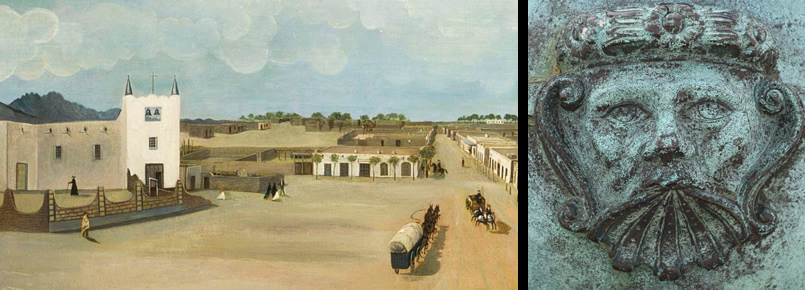

American Latino Heritage
Tumacácori National Historical Park
Tumacácori, Arizona
 |
San José de Tumacácori Mission Church
|
The native people who lived in the vicinity of Tumacácori called themselves “O’odham,” meaning “people” in their language. The Spanish called the O’odham that they found living along rivers “Pima,” and those that they found living in the desert, “Papago.” Their homeland included the area that is now southern Arizona and the northern part of the Mexican state of Sonora. A peaceful people unless the need arose to defend themselves, the O’odham were farmers, raising corn, beans and squash using flood irrigation. The people called “Papago” by the Spanish are known today as the Tohono O’odham, or “desert people.” Their famous basketry – once necessary for gathering and storing food – is made today using the same material-gathering and weaving techniques as were used by their ancestors.
|
Los Santos Angeles de Guevavi Mission Church Ruins |
Founded by Kino in January, 1691, mission San Cayetano de Tumacácori was the first mission to be located in what is now Arizona. Originally located on the east side of the Santa Cruz River, the mission moved – following a nearby rebellion in 1751 – to its present location on the west side of the river, where it was rechristened San José de Tumacácori. By 1757, the community had built a small adobe church. Beginning around 1800 – by this time under the administration of Franciscan missionaries – the community began construction of a larger church. Although in use by the early 1820s, the structure was never entirely completed. The last residents left Tumacácori in 1848.
The ruins of the larger church remain, a landmark in the Santa Cruz Valley. Also still visible are the remains of the priest’s residence and community area known as the convento, the granary where food was stored, the lime kiln where lime was heated to make mortar and plaster, and parts of the orchard and acequia, or irrigation ditch. Behind the church are the ruins of a cemetery and a mortuary chapel. A reproduction of a ki, or traditional O’odham house, is also on the site.
The Calabazas and Guevavi mission churches are in a more degraded state than Tumacácori, and are not open to the public. Visitors can tour these sites as part of reserved tours during winter months, and can learn about their history and stories at the Tumacácori museum. Founded a day after Tumacácori, Guevavi was designated the cabecera, or headquarters mission for the area. The name Guevavi was derived from the O’odham name for the community, Gu waihe, or “big well.” Like Tumacácori, the Guevavi mission church is an adobe structure. The newly arrived Franciscan missionaries moved their headquarters to Tumacácori in 1768, and within a few years the Guevavi mission was abandoned. The ruins of the 15 by 50 foot church built in 1751 are all that remains of the mission today.
|
Traditional Muuro-ki or O'odham house |
Father Pauer founded mission San Cayetano de Calabazas, a few miles north of Guevavi, in 1756. By 1786, primarily due to the continuous danger of attack by Apaches, the mission was abandoned, its residents moving to Tumacácori. It became a ranching outpost for the Tumacácori mission.
Visitors enter Tumacácori National Historical Park through the Tumacácori visitor center. The visitor center offers a 15 minute video, an excellent museum, and a bookstore. A self-guided interpretive tour booklet, “In the Footprints of the Past,” is available for loan or purchase in the bookstore. Guided tours are available at 11:00 and 2:00 January through March, and may be available at other times and seasons. Special tours, such as guided walks to the Santa Cruz River, may also be available. The park website describes tours currently available (nps.gov/tuma).
Tumacácori National Historical Park hosts La Fiesta de Tumacácori each year on the first full weekend in December. This event celebrates the many cultures that have historically been associated with the Santa Cruz Valley with traditional foods, crafts, music, and dance. A mass is held inside the mission church in October in conjunction with Tubac Presidio State Historic Park’s annual Anza Day event. The Juan Bautista de Anza National Historic Trail passes through the park, providing opportunities for walkers, bird watchers, and equestrians.
| Plan your visit |
Tumacácori National Historical Park, a unit of the National Park System and a National Historic Landmark, is located 45 miles south of Tucson, AZ off exit 29 on I-19. The visitor center for the Tumacácori National Historical Park is located at 1891 East Frontage Rd., Tumacácori, AZ and is open 9:00am to 5:00pm daily, except Thanksgiving Day and Christmas Day. Click for the National Register of Historic Places file: text and photos. There is an admission fee. For more information, visit the National Park Service Tumacácori National Historical Park website or call 520-398-2341. Tumacácori National Historical Park is also featured in the National Park Service Places Reflecting America's Diverse Cultures: Explore their Stories in the National Park System Travel Itinerary. |

